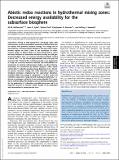Abiotic redox reactions in hydrothermal mixing zones: Decreased energy availability for the subsurface biosphere
Author(s)
McDermott, Jill M; Sylva, Sean P; Ono, Shuhei; German, Christopher R; Seewald, Jeffrey S
DownloadPublished version (947.7Kb)
Publisher Policy
Publisher Policy
Article is made available in accordance with the publisher's policy and may be subject to US copyright law. Please refer to the publisher's site for terms of use.
Terms of use
Metadata
Show full item recordAbstract
© 2020 National Academy of Sciences. All rights reserved. Subseafloor mixing of high-temperature hot-spring fluids with cold seawater creates intermediate-temperature diffuse fluids that are replete with potential chemical energy. This energy can be harnessed by a chemosynthetic biosphere that permeates hydrothermal regions on Earth. Shifts in the abundance of redox-reactive species in diffuse fluids are often interpreted to reflect the direct influence of subseafloor microbial activity on fluid geochemical budgets. Here, we examine hydrothermal fluids venting at 44 to 149 °C at the Piccard hydrothermal field that span the canonical 122 °C limit to life, and thus provide a rare opportunity to study the transition between habitable and uninhabitable environments. In contrast with previous studies, we show that hydrocarbons are contributed by biomass pyrolysis, while abiotic sulfate (SO42-) reduction produces large depletions in H2. The latter process consumes energy that could otherwise support key metabolic strategies employed by the subseafloor biosphere. Available Gibbs free energy is reduced by 71 to 86% across the habitable temperature range for both hydrogenotrophic SO42- reduction to hydrogen sulfide (H2S) and carbon dioxide (CO2) reduction to methane (CH4). The abiotic H2 sink we identify has implications for the productivity of subseafloor microbial ecosystems and is an important process to consider within models of H2 production and consumption in young oceanic crust.
Date issued
2020-08Department
Woods Hole Oceanographic Institution; Massachusetts Institute of Technology. Department of Earth, Atmospheric, and Planetary SciencesJournal
Proceedings of the National Academy of Sciences
Publisher
National Academy of Sciences
ISSN
1091-6490